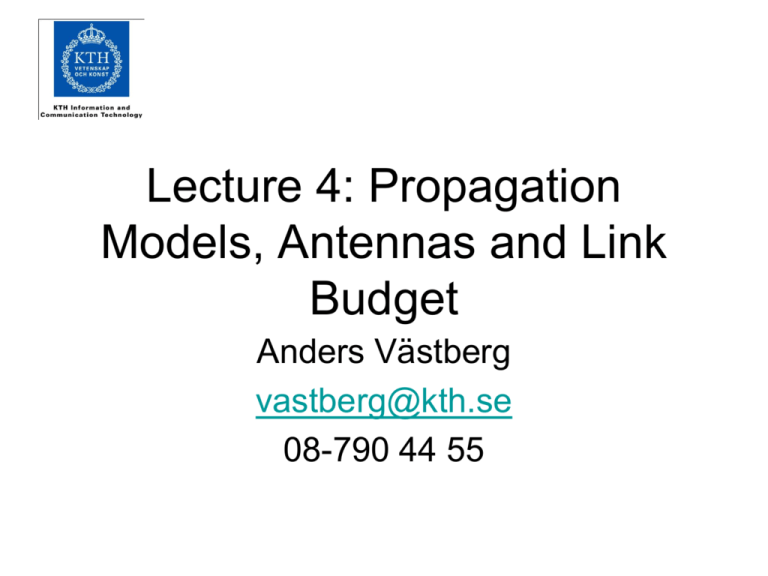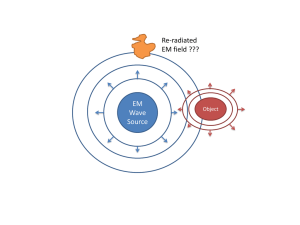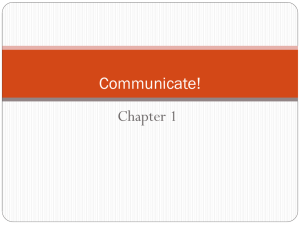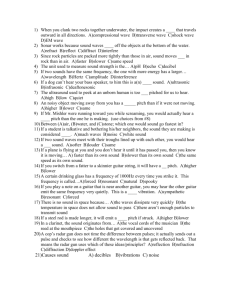No Ground Wave for Frequencies
advertisement

Lecture 4: Propagation Models, Antennas and Link Budget Anders Västberg vastberg@kth.se 08-790 44 55 Digital Communication System Source of Information Source Encoder Channel Encoder Digital Modulator Modulator RF-Stage Channel Information Sink Source Decoder Channel Decoder Digital Demodulator Demodulator RF-Stage [Slimane] Propagation between two antennas (not to scale) Sky Wave Direct Wave Ground Wave Ground Reflected Wave No Ground Wave for Frequencies > ~2 MHz No Ionospheric Wave for Frequencies > ~30 Mhz The Radio Link • Design considerations – The distance over which the system meets the performance objectives – The capacity of the link. • Performance determined by – Frequency – Transmitted Power – Antennas – Technology used [Black et. al] Performance of Radio Systems • Signal attenuation – path loss – multipath fading • Additive noise – Thermal noise – Atmospheric noise – Cosmic Noise – Man-made noise Noise • Thermal noise – White Noise • Spectral density: N 0 kT (W/Hz) k Boltzmann’s constant (1.38 10-23 J/K) T Absolute temperature (in Kelvins) • Noise power (in W) N kTB B Bandwidth (Hz) Signal to noise ratio (SNR) • Ratio between signal power and noise power 𝑆 𝑆 𝑆𝑁𝑅 = = 𝑁 𝑘𝑇𝐵 𝐸𝑏 𝑆/𝑅 𝑆 = = 𝑁0 𝑘𝑇 𝑘𝑇𝑅 𝑆𝑁𝑅 𝑘𝑇𝑅 𝑅 = = 𝐸𝑏 /𝑁0 𝑘𝑇𝐵 𝐵 Link Budget 𝑃𝑡 ∙ 𝐺𝑡 ∙ 𝐺𝑟 𝑃𝑟 = 𝐿𝑏 Pt Gt Lb 𝑃𝐸𝐼𝑅𝑃 = 𝑃𝑡 ∙ 𝐺𝑡 EIRP=Effective Isotropic Radiated Power r 𝑃𝑟 𝑃𝑡 ∙ 𝐺𝑡 ∙ 𝐺𝑟 𝑃𝑡 ∙ 𝐺𝑡 ∙ 𝐺𝑟 SNR = = = 𝑁 𝑁𝐿𝑏 𝑘𝑇0 𝐵𝐿𝑏 SNR 𝑑𝐵 = (𝑃𝑡 )𝑑𝐵 + (𝐺𝑡 )𝑑𝐵 − (𝐿𝑏 )𝑑𝐵 + (𝐺𝑟 )𝑑𝐵 − (𝑘𝑇0 𝐵)𝑑𝐵 Gr Pr Propagations Models Free Space Model Plane Earth Model Power Law Model 𝐿𝐹𝑆 4𝜋 𝑟 = 𝜆 𝐿𝑃𝐸 𝑟4 = ℎ1 ℎ2 𝑟𝑛 𝐿= 𝑘 2 2 4𝜋 𝑓𝑟 = 𝑐 2 Dipole antenna Omnidirectional L=l/2 • Half-wave dipole – Gain 1,64 = 2.15 dBi – Linear Polarisation I I • Quarter-wave dipole – Conducting plane below a single quarter wave antenna. Acts like a halfwave dipole L=l/4 I Yagi-antenna Directional 3-30 element and a gain of 8-20 dBi http://www.urel.feec.vutbr.cz/~raida/multimedia_en/chapter-4/4_3A.html Parabolic antenna Directional • Effective area Ae = hp d2/4 h0.56 [Stallings, 2005] Corner Reflectors • Multiple images results in increased gain • Example: G=12 dBi Images l/2 Driven Element Loop-antenna - Directional • Linear Polarisation • Gain 1,76 dBi http://www.ycars.org/EFRA/Module%20C/AntLoop.htm Helical antenna Directional • Normal mode • Axial mode http://hastingswireless.homeip.net/index.php?page=antennas&type=helical Microwave Communication [Slimane] Propagation in the Atmosphere • The atmosphere around the earth contains a lot of gases (1044 molecules) • It is most dense at the earth surface (90% of molecules below a height of 20 km). • It gets thinner as we reach higher and higher attitudes. • The refractive index of the air in the atmosphere changes with the Height • This affects the propagation of radio waves. • The straight line propagation assumption may not be valid especially for long distances. [Slimane] Effective Earth Radius [Slimane] Line-of-Sight Range [Slimane] Ray Paths and Wave fronts Fresnel Zone [Slimane] Ionospheric Communication [Davies, 1993] Indoor models Slow and Fast Fading Homework before F6 • Describe the following modulation methods: – AM, FSK, BPSK, QAM • Order ASK, FSK, PSK and DPSK in order of least efficient to most efficient.






